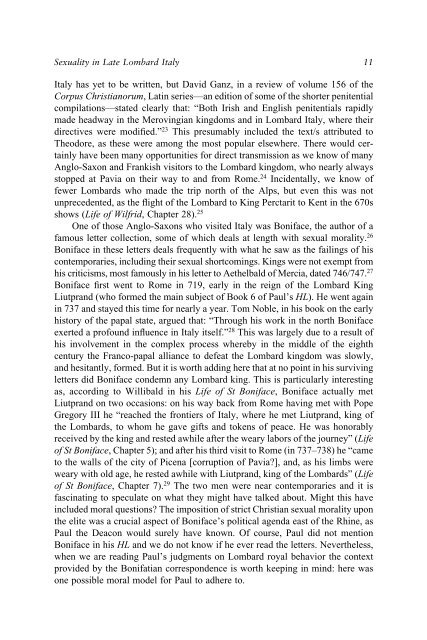Medieval Sexuality: A Casebook - Julian Emperor
Medieval Sexuality: A Casebook - Julian Emperor
Medieval Sexuality: A Casebook - Julian Emperor
Create successful ePaper yourself
Turn your PDF publications into a flip-book with our unique Google optimized e-Paper software.
<strong>Sexuality</strong> in Late Lombard Italy 1111112342225672228910111232224567892022212345678930111123435678940111123222Italy has yet to be written, but David Ganz, in a review of volume 156 of theCorpus Christianorum, Latin series—an edition of some of the shorter penitentialcompilations—stated clearly that: “Both Irish and English penitentials rapidlymade headway in the Merovingian kingdoms and in Lombard Italy, where theirdirectives were modified.” 23 This presumably included the text/s attributed toTheodore, as these were among the most popular elsewhere. There would certainlyhave been many opportunities for direct transmission as we know of manyAnglo-Saxon and Frankish visitors to the Lombard kingdom, who nearly alwaysstopped at Pavia on their way to and from Rome. 24 Incidentally, we know offewer Lombards who made the trip north of the Alps, but even this was notunprecedented, as the flight of the Lombard to King Perctarit to Kent in the 670sshows (Life of Wilfrid, Chapter 28). 25One of those Anglo-Saxons who visited Italy was Boniface, the author of afamous letter collection, some of which deals at length with sexual morality. 26Boniface in these letters deals frequently with what he saw as the failings of hiscontemporaries, including their sexual shortcomings. Kings were not exempt fromhis criticisms, most famously in his letter to Aethelbald of Mercia, dated 746/747. 27Boniface first went to Rome in 719, early in the reign of the Lombard KingLiutprand (who formed the main subject of Book 6 of Paul’s HL). He went againin 737 and stayed this time for nearly a year. Tom Noble, in his book on the earlyhistory of the papal state, argued that: “Through his work in the north Bonifaceexerted a profound influence in Italy itself.” 28 This was largely due to a result ofhis involvement in the complex process whereby in the middle of the eighthcentury the Franco-papal alliance to defeat the Lombard kingdom was slowly,and hesitantly, formed. But it is worth adding here that at no point in his survivingletters did Boniface condemn any Lombard king. This is particularly interestingas, according to Willibald in his Life of St Boniface, Boniface actually metLiutprand on two occasions: on his way back from Rome having met with PopeGregory III he “reached the frontiers of Italy, where he met Liutprand, king ofthe Lombards, to whom he gave gifts and tokens of peace. He was honorablyreceived by the king and rested awhile after the weary labors of the journey” (Lifeof St Boniface, Chapter 5); and after his third visit to Rome (in 737–738) he “cameto the walls of the city of Picena [corruption of Pavia?], and, as his limbs wereweary with old age, he rested awhile with Liutprand, king of the Lombards” (Lifeof St Boniface, Chapter 7). 29 The two men were near contemporaries and it isfascinating to speculate on what they might have talked about. Might this haveincluded moral questions? The imposition of strict Christian sexual morality uponthe elite was a crucial aspect of Boniface’s political agenda east of the Rhine, asPaul the Deacon would surely have known. Of course, Paul did not mentionBoniface in his HL and we do not know if he ever read the letters. Nevertheless,when we are reading Paul’s judgments on Lombard royal behavior the contextprovided by the Bonifatian correspondence is worth keeping in mind: here wasone possible moral model for Paul to adhere to.













